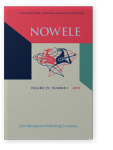Article published In:
NOWELEVol. 70:1 (2017) ► pp.57–72
Borrowing, incomplete lexical diffusion and the High German tenues shift
Building on Callender 2012, this paper argues that residue from the High German tenues shift may be the result of incomplete lexical
diffusion (as opposed to later northern borrowing). Although unshifted forms rarely appear in OHG texts (see Braune 2004 [1886]), an
examination of the TITUS corpus and Schützeichel 1995 revealed that their shifted counterparts were also largely absent. This suggests that
these forms were simply not the types of words written in OHG texts. Incomplete lexical diffusion thus remains a plausible explanation. I
also argue that affrication and spirantization may have been phonologically (perceptually) abrupt. Furthermore, there was little distinction
between the two post-vocalically for old short stops, a position where affricates do not survive today.
This article is currently available as a sample article.
References
Bauer, E.
1957 Dialektgeographie im südlichen Odenwald und Ried. Marburg: Elwert.

Braune, W.
1874 Zur Kenntnis des Fränkischen und zur hochdeutschen Lautverschiebung.
Beiträge zur Geschichte der deutschen Sprache und Literatur 11. 1–56.


Braune, W.
1886 Althochdeutsche Grammatik. Halle: Niemeyer

Braune, W.
2004 Althochdeutsche Grammatik I. Laut- und Formenlehre. Ingo Reiffenstein (ed.), (15th edition). Tübingen: Niemeyer.


Brinkmann, H.
1941 Der lautliche Vorgang der germanischen und der hochdeutschen Lautverschiebung.
Archiv für vergleichende Phonetik 51. 10–20; 77–89.

Bromm, E.
1936 Studien zur Dialektgeographie der Kreise Marburg, Kirchhain, Frankenberg. Marburg: Elwert.

Bruch, R.
1953 Mittelfränkische Relikte des Zwischenstadiums der Affrikata in der Lautverschiebung zur Spirans (kreits “Kreis”).
Zeitschrift für Mundartforschung 231. 129–47.

Bubner, R. H.
1935 Untersuchungen zur Dialektgeographie des Bergischen Landes zwischen Agger und Dhünn. Marburg: Elwert.

Fourquet, J. and P. Valentin.
1962 Althochdeutsche Phonemsysteme (Isidor, Tatian, Otfrid, Notker).
Zeitschrift für Mundartforschung 291: 341–56.

Frings, T.
1957 Grundlegung einer Geschichte der deutschen Sprache. Halle: Niemeyer.

Gippert, J., J. Martínez, & A. Korn
. (Updated
June 28 2013)
Thesaurus Indogermanischer Text- und Sprachmaterialien (TITUS).
[URL].
Goblirsch, K.
2005 Lautverschiebungen in den germanischen Sprachen. Heidelberg: Winter.

Haubrichs, W.
1979 Georgslied und Georgslegende im frühen Mittelalter. Königstein: Scriptor.

Hennig, B.
1998 Kleines Mittelhochdeutsches Wörterbuch. Tübingen: Niemeyer.

Hoffmann, K.
1900 Laut- und Flexionslehre der Mundart der Moselgegend von Oberham bis zur Rheinprovinz. Metz: Buchdruckerei der Lothringer Zeitung.

Hogg, R.
1988 On the Impossibility of Old English Dialectology. In:
D. Kastovsky &
G. Bauder (eds.),
Luick Revisited, 183–203. Tübingen: Narr.

Hogg, R.
2006 Old English Dialectology. In
A. van Kemenade and
B. Los (eds.),
The Handbook of the History of English, 395–416. Malden: Blackwell.


Hommer, E.
1915 Studien zur Dialektgeographie des Westerwaldes. Marburg: Elwert.

Honeybone, P.
2001 Lenition Inhibition in Liverpool English.
English Language and Linguistics 5, 2. 213–49.


Jardon, A.
1891 Grammatik der Achener Mundart. I. Teil: Laut- und Formenlehre. Aachen: Cremer.

Kiparsky, P.
1988 Phonological Change. In:
F. Newmeyer (ed.),
Linguistics: The Cambridge survey. Vol. I. Linguistic theory: Foundations, 363–415. Cambridge: Cambridge University Press.

Kiparsky, P.
1995 The Phonological Basis of Sound Change. In:
John Goldsmith (ed.),
The Handbook of Phonological Theory, 640–670. Cambridge, MA: Blackwell.

Klein, P.
1855 Die Sprache der Luxemburger. Luxemburg: Buck.

Kroh, W.
1915 Beiträge zur nassauischen Dialektgeographie.

Kuhl, Patricia K.
1991 Human Adults and Human Infants Show a “Perceptual Magnet Effect” for the Prototypes of Speech Categories, Monkeys Do Not.
Perception & Psychophysics 50, 2: 93–107.


Kuntze, E.
1932 Studien zur Mundart der Stadt Saarbrücken. Deutsche Dialektgeographie 311. Marburg: Elwert.

Labov, W.
2007 Transmission and Diffusion.
Language 83, 2. 344–387.


Lerchner, G.
1971 Zur II. Lautverschiebung im Rhineisch-Westmitteldeutschen. Diachronische und diatopische Untersuchungen. Halle: Niemeyer.

Matzel, K.
1970 Untersuchungen zur Verfasserschaft, Sprache und Herkunft der althochdeutschen Übersetzungen der Isidor-Sippe. Bonn: Röhrscheid.

Mettke, H.
1983 Mittelhochdeutsche Grammatik (5th edition). Leipzig: VEB Bibliographisches Institut.

Münch, F.
1904 Grammatik der ripuarisch-fränkischen Mundart. Bonn: Cohen.

Nordmeyer, G.
1936 Lautverschiebungserklärungen.
Journal of English and Germanic Philology 351. 482–495.

Ohala, J.
1993 The phonetics of sound change. In
C. Jones (ed.),
Historical Linguistics: Problems and Perspectives, 237–278. London: Longman.

Paul, H.
1989 Mittelhochdeutsche Grammatik (23rd edition). Tübingen: Niemeyer.

Penzl, H.
1971 Lautsystem und Lautwandel in den althochdeutschen Dialekten. Munich: Hueber.

Prokosch, E.
1933 A Comparative Germanic Grammar. Baltimore: Linguistic Society of America.

Roedder, E.
1936 Volkssprache und Wortschatz des Badischen Frankenlandes dargestellt auf Grund der Mundart von Oberschefflenz. New York: Modern Language Association.

Sapir, E.
1933 The Psychological Reality of Phonemes. Reprinted in Mandelbaum (ed.) 1949,
Selected Writings of Edward Sapir in Language, Culture, and Personality, 46–59. Berkeley: University of California Press.

Scheer, T.
2005 How Minimal is Phonological Change? Folia Linguistica Historica 251. 69–114.

Schützeichel, R.
1956 Zur ahd. Lautverschiebung am Mittelrhein.
Zeitschrift für Mundartforschung 241. 112–24.

Schützeichel, R.
1976 Die Grundlagen des westlichen Mitteldeutschen (2nd edition). Tübingen: Niemeyer.

Schützeichel, R.
1995 Althochdeutsches Wörterbuch (5th edition). Tübingen: Niemeyer.

Sendlmeier, W.
2000 Lautsprachliche Informationsverarbeitung beim Fremdsprachenerwerb. In:
U. A. Kauzner (ed.)
Pronunciation and the Adult Learner: Limitations and Possibilities, 113–128. Bologna: CLUEB.

Simmler, F.
1974 Die westgermanische Konsonantengemination unter besonderer Berücksichtigung des Althochdeutschen. Münsterische Mittelalter-Schriften 19. Munich: Fink.

Steinmeyer, E.
1916 Die kleineren althochdeutschen Sprachdenkmäler. Berlin: Weidmannsche Buchhandlung.

Tarral, N.
1903 Laut- und Formenlehre der Mundart des Kantons Falkenberg in Lothr. Strassbourg: Heitz and Mündel.

Voyles, J.
1974 The Phonology of the OHG Isidor. In:
Probleme der Historischen Phonologie, 69–106. Wiesbaden: Steiner.

Welter, W.
1938 Die Mundarten des Aachener Landes als Mittler zwischen Rhein und Maas. Bonn: Röhrscheid.

Wilmanns, W.
1911 Deutsche Grammatik. Gotisch, Alt-, Mittel- und Neuhochdeutsch (3rd edition). Straßburg: Trübner.

Yang, Charles
2006 The Infinite Gift. How Children Learn and Unlearn the Languages of the World. New York: Scribner.

Cited by
Cited by 1 other publications
Hinskens, Frans
2020.
The Expanding Universe of the Study of Sound Change. In
The Handbook of Historical Linguistics,
► pp. 5 ff.

This list is based on CrossRef data as of 8 april 2024. Please note that it may not be complete. Sources presented here have been supplied by the respective publishers.
Any errors therein should be reported to them.
